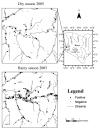Temporal and spatial stability of Anopheles gambiae larval habitat distribution in Western Kenya highlands
- PMID: 20021640
- PMCID: PMC2803444
- DOI: 10.1186/1476-072X-8-70
Temporal and spatial stability of Anopheles gambiae larval habitat distribution in Western Kenya highlands
Abstract
Background: Localized mosquito larval habitat management and the use of larvicides have been proposed as important control tools in integrated malaria vector management programs. In order to optimize the utility of these tools, detailed knowledge of the spatial distribution patterns of mosquito larval habitats is crucial. However, the spatial and temporal changes of habitat distribution patterns under different climatic conditions are rarely quantified and their implications to larval control are unknown.
Results: Using larval habitat data collected in western Kenya highlands during both dry and rainy seasons of 2003-2005, this study analyzed the seasonal and inter-annual changes in the spatial patterns in mosquito larval habitat distributions. We found that the spatial patterns of larval habitats had significant temporal variability both seasonally and inter-annually.
Conclusions: The pattern of larval habitats is extremely important to the epidemiology of malaria because it results in spatial heterogeneity in the adult mosquito population and, subsequently, the spatial distribution of clinical malaria cases. Results from this study suggest that larval habitat management activities need to consider the dynamic nature of malaria vector habitats.
Figures



Similar articles
-
Habitat stability and occurrences of malaria vector larvae in western Kenya highlands.Malar J. 2009 Oct 21;8:234. doi: 10.1186/1475-2875-8-234. Malar J. 2009. PMID: 19845968 Free PMC article.
-
Spatial relationship between adult malaria vector abundance and environmental factors in western Kenya highlands.Am J Trop Med Hyg. 2007 Jul;77(1):29-35. Am J Trop Med Hyg. 2007. PMID: 17620627
-
Response of Anopheles gambiae s.l. (Diptera: Culicidae) to larval habitat age in western Kenya highlands.Parasit Vectors. 2013 Jan 16;6:13. doi: 10.1186/1756-3305-6-13. Parasit Vectors. 2013. PMID: 23324330 Free PMC article.
-
Landscape determinants and remote sensing of anopheline mosquito larval habitats in the western Kenya highlands.Malar J. 2006 Feb 16;5:13. doi: 10.1186/1475-2875-5-13. Malar J. 2006. PMID: 16480523 Free PMC article.
-
Progress towards understanding the ecology and epidemiology of malaria in the western Kenya highlands: opportunities and challenges for control under climate change risk.Acta Trop. 2012 Jan;121(1):19-25. doi: 10.1016/j.actatropica.2011.10.002. Epub 2011 Oct 12. Acta Trop. 2012. PMID: 22015426 Free PMC article. Review.
Cited by
-
Physico-chemical and biological characterization of anopheline mosquito larval habitats (Diptera: Culicidae): implications for malaria control.Parasit Vectors. 2013 Nov 4;6(1):320. doi: 10.1186/1756-3305-6-320. Parasit Vectors. 2013. PMID: 24499518 Free PMC article.
-
Random repeated cross sectional study on breeding site characterization of Anopheles sinensis larvae in distinct villages of Yongcheng City, People's Republic of China.Parasit Vectors. 2012 Mar 23;5:58. doi: 10.1186/1756-3305-5-58. Parasit Vectors. 2012. PMID: 22444032 Free PMC article.
-
Topographic models for predicting malaria vector breeding habitats: potential tools for vector control managers.Parasit Vectors. 2013 Jan 16;6:14. doi: 10.1186/1756-3305-6-14. Parasit Vectors. 2013. PMID: 23324389 Free PMC article.
-
Analysing the generality of spatially predictive mosquito habitat models.Acta Trop. 2011 Jul;119(1):30-7. doi: 10.1016/j.actatropica.2011.04.003. Epub 2011 Apr 20. Acta Trop. 2011. PMID: 21527240 Free PMC article.
References
-
- Lengeler C. The Cochrane Library. Oxford; 1998. Insecticide treated bednets and curtains for malaria control (Cochrane Review) - PubMed

